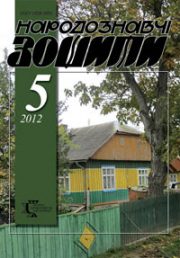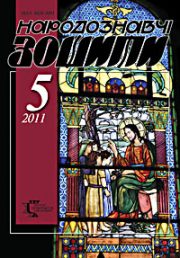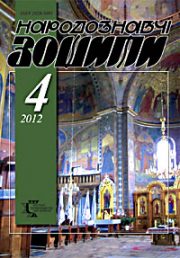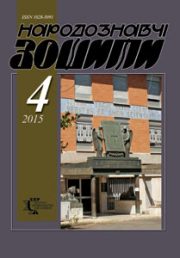The Ethnology Notebooks. 2021. # 2 (158), P. 424—434
УДК 27-526.63+398(477):(2-523.45)
DOI https://doi.org/10.15407/nz2021.02.424
Oksana KULISH
- ORCID ID: https://orcid.org/0000-0002-9625-0690
- Candidate of Sciences in Art Studies (Ph. D), Senior Researcher
- of the Cherkasy Regional Museum of Local Lore
- 1, Slavy street, 18000, Cherkasy, Ukraine,
- e-mail: kulish_oxana_andre@ukr.net
METAPHOR OF THE UKRAINIAN FOLK ICON «THE UNSLEEPING EYE» FROM SUBOTIV
Abstract. The article provides an analysis of the visual content of a unique sample of Ukrainian sacred painting, it is about the icon «The Unsleeping Eye» from Subotiv of the second half of the 18th century.
The object of the research is the Ukrainian folk icon «The Unsleeping Eye».
The subject is a metaphor of the folk icon «The Unsleeping Eye» from Subotiv.
The topicality of this article is due to the formation of the cultural-historical type of the Ukrainian narrative that, through a visual ontological metaphor is designed from Cossack times to the present day. This narrative is related to the heroic theme of the liberation struggle of the Ukrainian people for their national and spiritual identity, for their statehood.
Tasks of the article: to find out what is the manifestation of the visual ontological metaphor in relation to the icon «The Unsleeping Eye» from the Elijah’s Church of Subotiv. The method of synthesis of ethnographic, historical and art data is used in the research and methods of induction, comparativism, iconological analysis.
The purpose: to consider the visual ontological metaphor of the folk icon «The Unsleeping Eye» from Subotiv in the retrospect of history and old Ukrainian culture.
The basis of the work is an exhibit «Christ the Unsleeping Eye» and information about it in the unified passport from the documentary-material fund of the Cherkasy Regional Museum of Local Lore. The boundaries of the visual ontological metaphor of the represented icon are determined directly within the facts from the history of the Middle Dnieper region of the second half of the 17—18th centuries, and belonging to that history Chyhyryn’s land as part of the Polish-Lithuanian Commonwealth, also within cultural boundaries, namely the sacred architecture of Subotiv of that time and the ancient Ukrainian mythology, in which the Christian faith was superimposed on the pagan vision of a world about the Holy Prophet Elijah and the God’s Archangel Michael as the Thunderers.
Keywords: the Ukrainian folk icon «The Unsleeping Eye», Subotiv, the visual ontological metaphor, the God Infant, St. Elijah, St. Michael the Archangel, sacred architecture.
REFERENCES
- Ovsijchuk, V., Krvavych, D., & Pavliuk, S. (Ed.). (2000). The story of the icon. Lviv: Institute of Ethnology of the National Academy of Sciences of Ukraine [in Ukrainian].
- Adamovych, O.V. (2001). The style icons «The Unsleeping Eye» on materials collection of the National Kyiv-Pechersk Historical and Cultural Reserve. The image of Christ in Ukrainian culture: a collection (Pр. 129—138). Kyiv: NaUKMA [in Ukrainian].
- Najden, Oleksandr, & Babak, M. (Eds.). (2009). Folk icon of the Middle Dnieper region in the context of the peasant cultural space. The Rylsky Institute of Art Studies, Folklore and Ethnology NASU. Kyiv: Knyha [in Ukrainian].
- Syvak, Vasyl’. (2011). Eucharistic iconography in Ukrainian sacral paintings of the 17th— 18th centuries. The Ethnology Notebooks, 1 (97), 87—100 [in Ukrainian].
- Svientsits’ka, Vira. (1971). The main stages of development of Ukrainian painting of the 16th—18th centuries and reflection the phenomenas of musical culture in works of art. Ukrains’ke muzykoznavstvo (Issue 6, pp. 216—227) [in Ukrainian].
- Zholtovs’kyj, P.M. (1978). Ukrainian painting of the 17th—18th centuries. Kyiv: Naukova dumka [in Ukrainian].
- Otkovych, V.P. (1990). Folk trend in Ukrainian painting of the 17th—18th centuries. The Rylsky Institute of Art Studies, Folklore and Ethnology. Lviv branch. Kyiv: Naukova dumka [in Ukrainian].
- Stepovyk, Dmytro. (2004). A History of Ukrainian icon of the 10th—20th centuries. Kyiv: Lybid’ [in Ukrainian].
- Kramarchuk, Kh.P. (2009). The kinds and types of metaphors in design. Analytical method of searching for organic metaphor. Bulletin of Lviv Polytechnic National University, 656, 44—52 [in Ukrainian].
- Mikeshina, L.A., Openkov, M.Yu., & Levit, S.Ja. (Ed.). (1998). Metaphor optical. Culturology. The 20th century. Encyclopedia (Vol. 2, pp. 36—41). SPb: University book; Aleteya [in Russian].
- Khamitov, Nazip. (2007). Mifolohema. The Philosophical Dictionary: Human and world. Kyiv: KNT, Center for Educational Literature (Pp. 135—136) [in Ukrainian].
- Atlas of the administrative-territorial structure of Ukraine: 2020. Retrieved from: https://atu.decentralization.gov.ua/#atlas (Last accessed: 02.01.2021) [in Ukrainian].
- Nesterenko, V.I. (Ed.). (2017). The Cherkasy Regional Museum of Local Lore. Fund, Ж-642. Icon «The Unsleeping Eye of Christ» [in Ukrainian].
- Najden, Oleksandr. (2001). Ukrainian baroque. General features. Specifics of historical functioning. Mystetstvoznavstvo Ukrainy (Issue 2, pp. 25—33) [in Ukrainian].
- Hedz’, Tetiana. Visitation description of the church of St. of the prophet Elijah in Subotiv
- of 1750. Local Lore. Retrieved from: https://www.myslenedrevo.com.ua/uk/Sci/Local/VizytSubotiv1750.html (Last accessed: 12.01.2021) [in Ukrainian].
- Yurchenko, S. (2011). St. Elijah’s Church in Subotiv and an attempt to revive the Ukrainian architecture of the third quarter of the 17th century. Baroque architectural geography in Ukraine: regional features and common features (Pp. 27—31) [in Ukrainian].
- Diadychenko, V. (1959). Essays on the socio-political system of the Left Bank of Ukraine of the late 17th & early 18th centuries. Kyiv: Publishing house UkSSR Academy of Sciences [in Ukrainian].
- Riznyk, O.O, Chentsova, N.V, & Editorial Board: Kudryts’kyj, A.V. (Ed.). (1995). Military music. Art of Ukraine: Encyclopedia: in 5 vol. (Vol. 1, pp. 341—342). Kyiv: Ukr. entsyklopediya [in Ukrainian].
- Yavornytsky, D.I. (Ed.). (1991). From Ukrainian antiquity: Album. Kyiv: Mystetstvo [in Ukrainian].
- Kuksa, N.V. (2011). Elijah’s Church in Subotiv in the studios of the 19th — early 20th centuries. Pam’iatky Ukrainy: history and culture. National Historical and Cultural Reserve «Chyhyryn», 5—6, 38—47 [in Ukrainian].
- Lazurenko, V.M. (2019). In search of the crypt of the great statesman of Ukraine Bohdan Khmelnytsky. Burial of Hetman of Ukraine Bohdan Khmelnytsky in the Church of St. Elijah in the village of Subotiv: from centuries of research, legends and myths to modern scientific hypotheses. Cherkasy: Vertykal’ [in Ukrainian].
- Kuksa, N.V. (2013). St. Michael’s Church in Subotiv at «The Description of the pious foreigners wearing the Polish crown» by Melchizedek Znachko-Yavorsky. Siverschyna v istorii Ukrainy (Issue 6, pp. 293—295) [in Ukrainian].
- Kuksa, N.V. (2011). St. Elijah’s Church in Subotiv: the main stages of restoration of the architectural monument of the middle of the 17th century. Siverschyna v istorii Ukrainy (Issue 4, pp. 31—35) [in Ukrainian].
- Lazurenko, V.M. (2006). Here, every stone remembers the Hetman. Subotiv — country residence of Hetman of Ukraine Bohdan Khmelnytsky. Cherkasy: Vash dim [in Ukrainian].
- Kuksa, Nadiia. The fate of the ruins of the Khmelnytsky family castle in Subotiv. Retrieved from: https://shron1.chtyvo.org.ua/Kuksa_Nadiia/Dolia_ruin_zamku_rodyny_Khmelnytskykh_u_Subotovi.pdf?PHPSESSID=a8dca3179212f69de62c3070eec91f26 (Last accessed: 16.01.2021) [in Ukrainian].
- Kuksa, N.V. (2012). St. Elijah’s Church in Subotiv at «The Description of the pious foreigners wearing the Polish crown» by Melchizedek Znachko-Yavorsky. Novi doslidzhennia pam’iatok kozats’koi doby v Ukraini (Issue 21 (2), pp. 128—131) [in Ukrainian].
- Hradova, Anna. (2015). The Hetmans of Ukraine. The stories of fame, wisdom and courage. Kharkiv: Vivat [in Ukrainian].
- Tairova-Yakovleva, Tatiana. (2020). The Bohdan Khmelnytskyi’s Grave in Subotiv and the Prospects of its Search. Ukrains’kyj istorychnyj zhurnal, 4, 21—28 [in Ukrainian].
- Voropaj, Oleksa. (1958). Customs of our people. The Ethnographic Essay (Vol. 2: Summer-autumn). Munich: Ukrains’ke vydavnytstvo [in Ukrainian].
- Nechuj-Levyts’kyj, Ivan, Kravchenko, N., & Scherbakova, N. (Eds.). (2003). Worldview of the Ukrainian people. Sketch of Ukrainian mythology.. Kyiv: Oberehy [in Ukrainian].
- Kylymnyk, Stepan. (1963). The Ukrainian year in folk customs within historical context: in 5 vol. (Vol. 5: Autumn cycle). Winnipeg; Toronto [in Ukrainian].
- Mel’nychuk, O.S. (Ed.). (1974). Dictionary of foreign words. Kyiv: Holovna redaktsiia URE [in Ukrainian].







